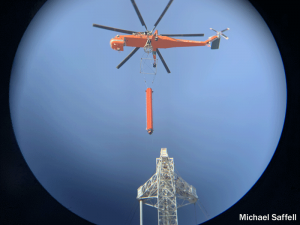NorthEast Radio Watch 3/31/2025: Jim Quinn Signs Off
In this week’s issue… Remembering Pittsburgh's Quinn - Seven Mountains enters Harrisburg - My launches new brands - Ryan out at B101 - More cuts at Radio Vermont - Another AM deleted
By SCOTT FYBUSH
 It’s time once again for our Year in Review, the 26th time we’ve gathered up our headlines from the previous 12 months and tried to sum it all up for you.
It’s time once again for our Year in Review, the 26th time we’ve gathered up our headlines from the previous 12 months and tried to sum it all up for you.
Last week, we brought you The Year in Station Sales (here) and The Year in People and Formats (here and here).
This week, we’re doing the “Top Ten Stories of the Year” portion of our Year in Review in two installments: we counted down stories 10 through 6 yesterday, and we finish up with stories 5 through 1 today. We’ll wrap up the whole package on New Year’s Day with “Those We Lost,” and we’ll resume our regular NorthEast Radio Watch report with an update on Monday, January 6. In the meantime, our own Twitter and Facebook feeds and RadioInsight will be here with any breaking news!
Two of the oldest names in broadcasting bowed out in 2019, with considerable implications in NERW-land.
 Tribune, with roots in radio and TV back to the earliest days of WGN in Chicago and WPIX in New York, completed its sale to Nexstar after an earlier deal with Sinclair couldn’t win regulatory approval. But with Nexstar already deeply entrenched in many of Tribune’s NERW-land markets, the deal required lots of spin-offs: in New York, the national ownership cap didn’t allow Nexstar to add Tribune’s WPIX (Channel 11), so that CW affiliate went to Scripps instead, but with an option for Nexstar to buy it if the caps change.
Tribune, with roots in radio and TV back to the earliest days of WGN in Chicago and WPIX in New York, completed its sale to Nexstar after an earlier deal with Sinclair couldn’t win regulatory approval. But with Nexstar already deeply entrenched in many of Tribune’s NERW-land markets, the deal required lots of spin-offs: in New York, the national ownership cap didn’t allow Nexstar to add Tribune’s WPIX (Channel 11), so that CW affiliate went to Scripps instead, but with an option for Nexstar to buy it if the caps change.
In several other markets, duopoly rules kept Nexstar from adding the Tribune stations, so TEGNA ended up gaining ground instead – WTIC/WCCT in Hartford, WNEP in Scranton and WPMT in York joined the TEGNA fold, filling in some of that company’s gaps in the region, where it already owned stations in Buffalo, Portland and Bangor. When the dust (and the billions of dollars) settled, Nexstar ended up adding only one station in our region, MyNetwork affiliate WPHL (Channel 17) in Philadelphia.
Cox’s family roots in broadcasting also went back to the dawn of the medium, so the end of family ownership there was a big deal indeed, albeit even more so outside our region in markets such as Atlanta (WSB) and Dayton (WHIO) where it still held grandfathered newspaper-radio-TV clusters. Within NERW-land, Cox’s sale of most of its media assets to an investment group led by Apollo Global Management ended up resulting in little change for viewers and listeners: the Apollo-led group promptly renamed itself from Terrier Media to “Cox,” retaining existing management at properties that included WFXT in Boston, WPXI in Pittsburgh and WBAB/WBLI on Long Island.
The new Cox group also rolled in several Apollo-controlled stations that had been held under the Northwest banner, including Fox/My affiliates WSYT/WNYS in Syracuse and Fox affiliate WICZ in Binghamton; ownership cap issues will force the new Cox to surrender the separate WNYS license and run My on a subchannel of WSYT once that deal fully closes.
Outside of those two big deals, two other groups focusing on smaller markets made the only other TV moves in NERW-land: Gray added United’s WWNY/WNYF in Watertown to its holdings in Burlington, Bangor and Presque Isle, while Standard launched its group with WLNE in Providence, later adding WYDC in Corning-Elmira along with the related Sound Communications radio holdings there and in Olean.
We tend to reserve an annual spot here for Pacifica’s perpetually troubled WBAI in New York, and the only surprise in 2019 is that the station’s woes didn’t land it even higher on the list.
 Until the fall, it actually appeared as though WBAI might get through a year with only its usual low-level crises. Its 2018 appearance on the list was for the deal Pacifica reached with Public Media Capital to obtain a loan that allowed WBAI to pay off the millions it owed for back rent on the Empire State Building, and then to build out a new transmitter facility at 4 Times Square. Ending the ongoing Empire drama might, it seemed, have given WBAI a shot at some actual financial stability and a chance to build itself back up after a troubled decade.
Until the fall, it actually appeared as though WBAI might get through a year with only its usual low-level crises. Its 2018 appearance on the list was for the deal Pacifica reached with Public Media Capital to obtain a loan that allowed WBAI to pay off the millions it owed for back rent on the Empire State Building, and then to build out a new transmitter facility at 4 Times Square. Ending the ongoing Empire drama might, it seemed, have given WBAI a shot at some actual financial stability and a chance to build itself back up after a troubled decade.
But this is WBAI we’re talking about, after all, and “stability” isn’t a word that seems to fit its circumstances. This time, it was the tension between WBAI’s local staffers and the national board that flared in a big way. As the first loan payment was coming due in October, the national board lost patience with the local WBAI management over slow growth in membership revenue, reacting dramatically by closing WBAI’s Brooklyn studios, dismissing its paid staff and switching to a national program feed out of Pacifica’s Berkeley headquarters while planning to rebuild a more viable local operation in New York.
The local staff, of course, understood and supported the need for some kind of tough action, cooperating with Pacifi —
No, of course it didn’t, because it’s WBAI. Local staffers immediately began protesting what they called a “coup” (even though the station’s license is in fact held by national Pacifica, which is supposed to have ultimate responsibility over programming and operations), launching lawsuits and making noise in the media. After several tries in court, the local staff won, for now, with Pacifica ordered to reopen the local studios and reinstate the local programming.
And so things stand in the short term heading into 2020 (and the 60th anniversary of Pacifica’s ownership of WBAI). In the long term? That loan is still due, with no sign that the WBAI operation in its current form can generate the income needed to pay it. That has financial implications for the rest of Pacifica’s operations, with the threat always looming that the national board could finally decide to cut its losses and sell the valuable New York FM license.
As the AM radio dial approached its centennial year, the “senior band” was showing its age in 2019. If the sale of one big New York signal for a record low price wasn’t a good sign (WABC’s $12 million deal, about which more in a moment), how about Emmis’ apparent inability to sell smaller WLIB (1190) at all?
 With underlying land values rapidly exceeding the declining value of station licenses, it’s becoming increasingly common to see AM signals being downgraded or going silent completely. Pittsburgh’s KQV (1410) returned to the air at year’s end, almost two years after former owners took it silent – but it returned from a diplexed tower across town with only minimal night power, a significant downgrade from the fulltime 5,000-watt signal it used to have in the North Hills. Four of those five towers came down in 2019 as the site was sold, leaving just one to be rented for cellular and other newer uses. Boston’s WMEX (1510) also came back to the air from a downsized diplex facility, but long-promised plans for a new format continued to be pushed back there and at sister WBMS (1460) in Brockton, in favor of a continued FM simulcast. Philadelphia’s WNWR (1540) lost its directional site near the Roxborough antenna farm, also returning at reduced power from a diplexed site.
With underlying land values rapidly exceeding the declining value of station licenses, it’s becoming increasingly common to see AM signals being downgraded or going silent completely. Pittsburgh’s KQV (1410) returned to the air at year’s end, almost two years after former owners took it silent – but it returned from a diplexed tower across town with only minimal night power, a significant downgrade from the fulltime 5,000-watt signal it used to have in the North Hills. Four of those five towers came down in 2019 as the site was sold, leaving just one to be rented for cellular and other newer uses. Boston’s WMEX (1510) also came back to the air from a downsized diplex facility, but long-promised plans for a new format continued to be pushed back there and at sister WBMS (1460) in Brockton, in favor of a continued FM simulcast. Philadelphia’s WNWR (1540) lost its directional site near the Roxborough antenna farm, also returning at reduced power from a diplexed site.
Many AMs that remained on the air did so only to feed translators, with still more signing on from the 2017 and 2018 filing windows; in Portland, for instance, Saga ditched sports at WZAN (970) to feed a country format to an FM signal. In Albany, the trio of AMs formerly owned by Empire all returned as well, augmented by new translators feeding music formats on FM.
Some AMs were simply donated – WALK (1370) on Long Island, to Radio Cantico Nuevo, for instance – and a few went silent completely, most notably Quinnipiac University’s WQUN (1220) in Hamden, Connecticut, silencing a vibrant local full-service format.
There were, to be sure, some signs of confidence in AM’s future. In Reading, the bankruptcy of the parent Reading Eagle Company threatened WEEU (830), another healthy full-service voice in a relatively underserved radio market; Bob Lowe’s Twilight group won a bankruptcy bid for the license and struck a deal to continue operating the station from its existing studio and transmitter sites, adding a second outlying signal (WBYN 1160) to augment its coverage. And there were healthy sale prices for some stations with specialty formats, including Spanish-language (WHOL/WEST in Allentown) and Catholic (Starboard’s purchase of Salem stations that included WWDJ in Boston).
Another holdover we expected from our 2018 list was the continuing saga of the digital TV repack. Driven by the billions of dollars wireless companies paid for the upper end of the UHF spectrum (the former TV channels from 37 to 51), 2019 was the year most markets in NERW-land had to face the tight Congressionally-mandated schedule to move to new channels to clear out those upper frequencies (and fill some of the Swiss-cheese holes left behind in 2009 when analog TV signed off.)
 The industry expected some headaches because of the tight schedule and shortage of available crews and equipment, and those headaches materialized, in some cases even worse than expected. We knew, for instance, that Boston would be an especially challenging market because of just how many antennas and transmitters needed to be moved in close proximity – but there were unexpected issues with the transmission line and antennas at one of the two master sites, forcing most Boston stations to remain on what was supposed to be their auxiliary facility well into 2020. Equipment delays also affected stations in other markets, including Buffalo and Syracuse.
The industry expected some headaches because of the tight schedule and shortage of available crews and equipment, and those headaches materialized, in some cases even worse than expected. We knew, for instance, that Boston would be an especially challenging market because of just how many antennas and transmitters needed to be moved in close proximity – but there were unexpected issues with the transmission line and antennas at one of the two master sites, forcing most Boston stations to remain on what was supposed to be their auxiliary facility well into 2020. Equipment delays also affected stations in other markets, including Buffalo and Syracuse.
A handful of stations that accepted big money at auction to give up their UHF signals for VHF channels had the expected problems: in Boston, for instance, WGBH quickly applied for a power boost after its new VHF RF 5 signal had trouble reaching viewers.
Then there was Mount Mansfield high above Burlington, Vermont, where WCAX and WPTZ survived their repack only to see their shared antenna catch fire as winter was setting in. With equipment and crews in short supply, the Gray and Hearst stations still managed to get a temporary replacement flown in and installed – but with another year of repack still in the offing, it’s going to continue to be tense for an industry with little room for more errors or emergencies. (And when the repack ends and the antenna and transmitter manufacturers suddenly have to cope with a sharp drop-off in demand for their products? That may not be pretty, either.)
One bright spot in the repack was in New York, where John Lyons and his team pulled off a flawless game of chess as they moved stations back and forth between two combiners and antennas with FCC officials watching; that victory was tempered just weeks later, sadly, with news of John’s untimely death.
Some years, you know early on what the lead story is going to be. Standing in line to get through security at Yankee Stadium on the last evening of May, we had a pretty good idea that we’d be leading this column seven months later with what was in our earbuds: the final hours of commercial music radio on WPLJ (95.5) and the story it told of larger changes at parent company Cumulus.
 It’s true, of course, that the WPLJ that was being fulsomely mourned on and off the air all spring wasn’t so much the nondescript current hot AC station but the many decades of rock and top-40 music that had made the WPLJ calls so famous under ABC’s ownership in the 1970s and 1980s. As with so many farewells, there wouldn’t have been a sale of WPLJ if everyone who was bemoaning its demise had actually been tuned in for the last few years.
It’s true, of course, that the WPLJ that was being fulsomely mourned on and off the air all spring wasn’t so much the nondescript current hot AC station but the many decades of rock and top-40 music that had made the WPLJ calls so famous under ABC’s ownership in the 1970s and 1980s. As with so many farewells, there wouldn’t have been a sale of WPLJ if everyone who was bemoaning its demise had actually been tuned in for the last few years.
But the staff reunions, on and off the air, and the souvenir t-shirts and retrospective message board memories all spoke to a time when local radio was a more relevant force in music and popular culture. The particular nature of WPLJ’s departure, one of several Cumulus stations being sold to fast-growing EMF to become part of its national K-Love network, helped reinforce a narrative of radio becoming more generic and less local, even if EMF’s only role was as a willing buyer at a relatively bargain price compared to what a station like WPLJ might once have fetched.
Once WPLJ had been sent off to the sound of John Lennon’s “Imagine,” it started to become clear that its sale was really part of a larger revamping of Cumulus as CEO Mary Berner executes what appears to be a solid plan to bring the company back from the brink. If one of the downfalls of the Dickey-era Cumulus was its attempt to swallow Citadel, and in particular the big-market clusters Citadel had acquired from ABC/Disney, then one of the big pieces of the Berner-era cleanup appears to be unloading many of those former ABC stations.
That meant KLOS in Los Angeles, sold off to the fast-growing Meruelo Media group out there. It meant WPLJ and the five other stations (Atlanta, Washington, Savannah, San Jose and WXTL in Syracuse) that went to EMF for $103.5 million. And it meant WABC in New York, too, where Cumulus reached a deal to sell to John Catsimatidis’ Red Apple group for just $12.5 million.
“$12.5 million? That can’t include the land under the tower out in New Jersey, right?” was the immediate reaction – but it did, and even included a commitment from Cumulus to pay half the costs of cleaning up toxic waste out there left behind from the ABC era. With Catsimatidis yet to close on the WABC sale, we can confidently say that its next chapter is likely to be part of our 2020 Year in Review. (So, too, will be the fate of the last New York-market station in the cluster, little WNBM 103.9, which dumped its last local programming and has become just an automated clearinghouse for satellite programming.)
But in the meantime, Cumulus was finding some surprising levels of stability and even growth with the properties it’s keeping. Its end of the Connoisseur swap is a textbook example: in giving up WICC and WEBE in Connecticut, Cumulus bolstered what was already a successful cluster in the Lehigh Valley, adding Connoisseur’s “Cat Country” (WCTO 96.1) and “Hawk” (WODE 99.9) FM brands, along with two sports AMs, to its own AC WLEV (100.7). Cumulus quickly rebranded another former Connoisseur FM, WWYY (107.1), as an extension of the “Cat Country” signal, and moved WWYY’s former Allentown translator to a simulcast of the sports AMs.
The result was a much stronger cluster in the sort of small-to-medium market where Cumulus tends to do well, and where it’s now one of just two big players, head to head with iHeart.
Will 2020 bring more such strategic deals? Can Cumulus use the leverage of its national platforms, such as Westwood One, to make these smaller local operations sound big on the air? Will we see more experiments like the interesting one in Syracuse, where the former WXTL “Rebel Rocks” format stayed alive in streaming form, complete with PD Dave Frisina and a new lineup of local talent?
It may not be the sort of “everything’s going back to the good old days” story that many in the business would still love to be able to tell, but it might just be as good as things are going to get in the world of corporate radio heading into the 2020s.
(We’ll wrap up our Year in Review coverage tomorrow with a comprehensive look at the year in radio and TV obituaries.)
> > > Coming Wednesday, Jan. 1: Those We Lost

And if you don’t have your Tower Site Calendar, now’s the time!
If you’ve been waiting for the price to come down, it’s now 30 percent off!
This year’s cover is a beauty — the 100,000-watt transmitter of the Voice Of America in Marathon, right in the heart of the Florida Keys. Both the towers and the landscape are gorgeous.
And did you see? Tower Site of the Week is back, featuring this VOA site as it faces an uncertain future.
Other months feature some of our favorite images from years past, including some Canadian stations and several stations celebrating their centennials (buy the calendar to find out which ones!).
We still have a few of our own calendars left – as well as a handful of Radio Historian Calendars – and we are still shipping regularly.
The proceeds from the calendar help sustain the reporting that we do on the broadcast industry here at Fybush Media, so your purchases matter a lot to us here – and if that matters to you, now’s the time to show that support with an order of the Tower Site Calendar. (And we have the Broadcast Historian’s Calendar for 2025, too. Why not order both?)
Visit the Fybush Media Store and place your order now for the new calendar, get a great discount on previous calendars, and check out our selection of books and videos, too!
In this week’s issue… Remembering Pittsburgh's Quinn - Seven Mountains enters Harrisburg - My launches new brands - Ryan out at B101 - More cuts at Radio Vermont - Another AM deleted
Tower Site goes Jeeping (and fixing a flat tire!) up in the mountains of northwest New Jersey
In this week’s issue… New signal for Boston's WJIB - "New Standards" changes stations - New home for Maine FM - Remembering NYC's Diaz, Maine's "Mr. Mike," Albany's McGrath, Rochester's Petschke
A look at two of the Voice of America facilities that were abruptly shuttered this month